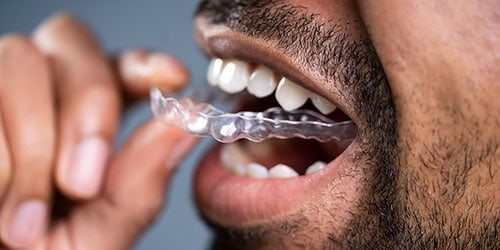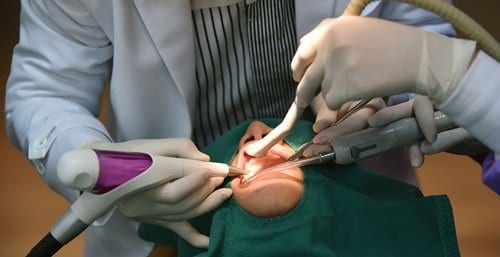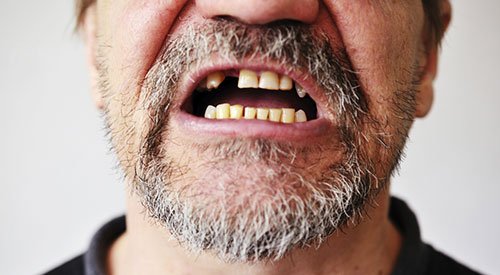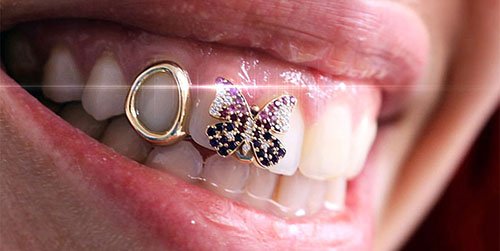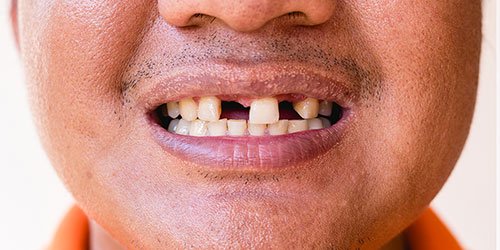The American Dental Association estimates that as many as 120 million Americans are missing at least one tooth. Losing one or more teeth can impact the appearance of your smile, potentially affecting your self-esteem. Tooth loss can also affect the way you talk and eat. However, there is more going on below the surface of your gums.
The integrity of your jawbone relies on things like biting and chewing to stimulate circulation. When a tooth is lost and not replaced, there is no stimulation, leading to jawbone deterioration. Deterioration, also known as “bone absorption,” can happen quickly and is a primary reason to address missing teeth.
In modern dentistry, various options are available for filling gaps in teeth, including dentures or partial dentures, dental implants, and dental bridges. Dental implants and bridges are more permanent solutions for missing teeth than dentures. However, they differ slightly and have different advantages and drawbacks.

Dental implants versus bridges
If you are considering bridges versus implants, your periodontist can provide guidance on which solution is right for you. However, understanding the similarities and differences can help you make an informed decision.
Both implants and bridges are designed to:
- Improve your ability to chew and bite food
- Enhance speech
- Support facial muscles
- Prevent jawbone loss (though to varying extents)
Although cost and personal preference should factor into your decision, deciding between a tooth implant and bridge largely comes down to the state of your mouth. This includes the health of your jawbone and the surrounding structures, as well as how many teeth you have remaining. The biggest difference between dental implants and bridges is how they are secured in the mouth.
What is a dental implant?
A missing tooth is more than a gap in your smile; it also affects the underlying structures, such as ligaments, nerves, and bone. Dental implants replace the missing tooth and provide a way for the jaw to be stimulated. It’s usually a good tooth replacement option for those looking to replace a single tooth.
During the procedure, a metal post will be surgically inserted into the jawbone below the gumline. It will act as an artificial tooth root and go through a process known as osseointegration. This is where new bone grows around the implant and fuses it in place. Once osseointegration is complete, an abutment (piece that connects the implant to the artificial tooth) can be added, and a dental crown can be placed. Your new artificial tooth will help transfer stimulation from chewing and biting to the implanted post, keeping the new bone healthy and strong.
What is a dental bridge?
Dental bridges do not implant into your bone. Instead, they rely on neighboring teeth. A bridge literally “bridges the gap” between existing teeth. Either crowns or metal structures on your remaining teeth hold the artificial teeth (pontics) in place.
A traditional bridge relies on crowns or tooth caps over the healthy teeth on either side of the gap (abutment teeth). False teeth are suspended between the crowns, forming a bridge over the space. It is a common choice for missing molars as crowns can better withstand chewing than other bridge options.
Alternatively, a Maryland dental bridge does not crown the teeth. Instead, it uses metal wings bonded to the neighboring teeth on either side of the gap. Generally, a Maryland bridge is only a solution for missing front teeth, as it is not strong enough to withstand chewing.
A cantilevered dental bridge uses two artificial teeth attached to a single healthy tooth. A healthy tooth can receive a crown fused to a second false tooth. The second tooth hangs over the gap in the gums, filling in the missing space without any support of its own. Like Maryland bridges, they’re not the most stable and can’t withstand frequent pressure.
The pros and cons of implants versus bridge work
When considering which is better, a bridge or implant, it is important to know that they both have advantages and drawbacks.
Oral health – a tooth implant versus dental bridge
Dental implants can aid oral health. First, because they do not rely on the surrounding teeth for support. Not only does this lessen stress on neighboring teeth, but implants can also help improve the jawbone’s health. The stimulation transferred through the artificial tooth and implant prevents further bone deterioration and loss of adjacent teeth.
Because bridges cannot transfer stimulation to the underlying jawbone, they don’t prevent bone loss. Even though a bridge cosmetically restores your smile, structural concerns can progress. To place a crown over healthy teeth for a bridge, enamel must be shaved off, which can increase susceptibility to decay and damage. When metal is cemented to healthy teeth, it can put strain on adjacent structures and weaken them over time.
Comparing the lifespan of dental bridges and implants
Dental implants can last a lifetime if they are properly cared for. Unlike bridges that can hinder proper cleaning, implant maintenance is identical to how you care for your natural teeth. If the artificial tooth becomes cracked or broken, it can be replaced without affecting the abutment and implant beneath. Some individuals report that dental implants are more comfortable than other types of dentures and bridgework. They are also less identifiable, blending in seamlessly with your natural teeth for years to come.
Unlike implants, dental bridges have an average lifespan of 5 to 15 years. They are susceptible to damage, which can cause them to become loose and allow tooth decay on the surrounding structures. Cemented bridges can make proper care of the gums and teeth tricky, potentially leading to gum disease or cavities. You should also be mindful about what you eat and drink, as your bridge may become discolored over time if frequently exposed to staining ingredients.
Tooth implant versus dental bridge procedure length and complications
Dental implant treatment plans include several procedures with wait times between each. There may be a need for a bone graft if you have too soft or little remaining jawbone. Bone grafting for dental implants can take a few months, as can osseointegration. From start to finish, the entire process can take anywhere from five months to a year. There are always risks associated with surgery. Even after oral surgery, improper hygiene can lead to complications such as peri-implantitis (infection of the gums) or implant failure.
On the other hand, a dental bridge procedure is much less invasive and time-intensive than a dental implant procedure. Dental bridges rest on top of the gums and do not require bone grafting or implantation. You’ll usually only need to see your periodontist twice during your dental bridge treatment. Our periodontist will take impressions and prepare the adjacent teeth during the first appointment and place your bridge during a second appointment a couple of weeks later.
Bridge versus implant cost
When considering the price of a bridge versus implant, dental implants tend to be a costlier treatment. This is because dental implants require a greater number of complex procedures over a longer period of time. The need for bone grafting can further increase the cost. Unfortunately, most dental insurance will not cover dental implants.
Compared to a dental implant procedure, receiving a dental bridge is often more affordable. Fewer and less invasive procedures are required, lowering the expense. Generally, our periodontists only need two appointments to prepare and place your bridge. Even better news for most is that many dental bridge treatments are covered by dental insurance.
Combination options – an implant-supported dental bridge
Depending on the number of missing teeth and their location in the mouth, our periodontists may recommend a combination of dental bridges and implants.
Dental implants can support a bridge on one or both ends. For example, if you are missing several molars, an implant can be placed at one end of the gap. Then, a traditional bridge can fill the gap, ending with a crown over a healthy tooth opposite the implant. A cantilevered bridge featuring an implant affixed to an artificial tooth is another single dental tooth implant option.
Alternatively, two implants can be placed, one on either end, where there are not enough remaining teeth to support a bridge. These implants can support a dental bridge instead of using several implants to fill a gap. Implant-supported dental bridges like these are ideal for those who have lost all or most of their teeth in a single area, or arch, of the jaw.
Implant-supported dental bridges can offer better stability than a dental bridge alone and address structural and cosmetic concerns by transferring some stimulation to the jawbone. A single implant-supported dental bridge can prevent healthy teeth from being crowned. However, combination options can involve each procedure’s positive and negative aspects. Implant-supported bridges are more costly than dental bridges and require multiple appointments to complete both treatment plans.
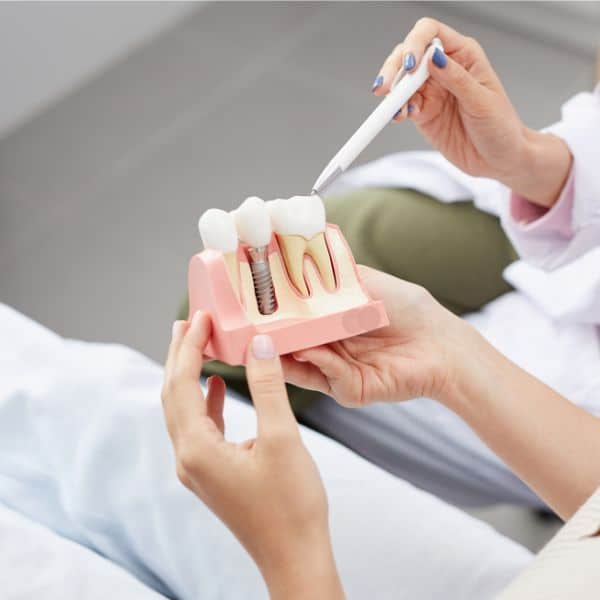
Which is better: a bridge or an implant?
Our periodontists can help you weigh the benefits and drawbacks of each treatment option. Their expert guidance allows you to make an informed decision about which missing tooth treatment is right for you. Deciding on implants vs. bridge work depends greatly on your specific oral health circumstances and goals.
Our periodontists aim for a healthy smile that will last for years while providing gentle treatment that suits your unique needs.
Choose MD Periodontics for your beautiful, healthy smile!
MD Periodontics is the premier periodontal facility for high-quality dental care. Located in Beverly Hills, we provide a wide range of dental services, including dental implants and bridges. Our patients are not only local but come to us from around the globe to have their oral health, quality of life, and smile restored. Our board-certified periodontists and their highly qualified, dedicated, and professional staff form a team that provides top-of-the-line technology, and skills gained from extensive experience.
Schedule a consultation online or call us at (310) 859-9449. MD Periodontics is conveniently located for patients throughout the metropolitan Los Angeles area. Our board-certified periodontists and implant dentistry experts are available at locations in or near Beverly Hills, Santa Monica, West Los Angeles, Culver City, West Hollywood, downtown Los Angeles, Marina del Rey, Pacific Palisades, Malibu, Manhattan Beach, Sherman Oaks, and Encino.
- The Best and Worst Habits for Your Teeth - November 7, 2024
- Are cavities contagious? - September 23, 2024
- The Differences Between Dental Bone Graft Materials - September 9, 2024
 (310) 859-9449
(310) 859-9449 Dental Implant Versus Dental Bridge: Which One is Right for You?
Dental Implant Versus Dental Bridge: Which One is Right for You?
 or call us at
or call us at 


























